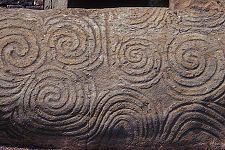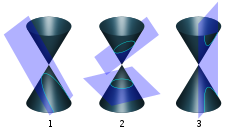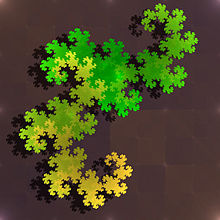Curve

Inmathematics,acurve(also called acurved linein older texts) is an object similar to aline,but that does not have to bestraight.
Intuitively, a curve may be thought of as the trace left by a movingpoint.This is the definition that appeared more than 2000 years ago inEuclid'sElements:"The [curved] line[a]is […] the first species of quantity, which has only one dimension, namely length, without any width nor depth, and is nothing else than the flow or run of the point which […] will leave from its imaginary moving some vestige in length, exempt of any width. "[1]
This definition of a curve has been formalized in modern mathematics as:A curve is theimageof anintervalto atopological spaceby acontinuous function.In some contexts, the function that defines the curve is called aparametrization,and the curve is aparametric curve.In this article, these curves are sometimes calledtopological curvesto distinguish them from more constrained curves such asdifferentiable curves.This definition encompasses most curves that are studied in mathematics; notable exceptions arelevel curves(which areunionsof curves and isolated points), andalgebraic curves(see below). Level curves and algebraic curves are sometimes calledimplicit curves,since they are generally defined byimplicit equations.
Nevertheless, the class of topological curves is very broad, and contains some curves that do not look as one may expect for a curve, or even cannot be drawn. This is the case ofspace-filling curvesandfractal curves.For ensuring more regularity, the function that defines a curve is often supposed to bedifferentiable,and the curve is then said to be adifferentiable curve.
Aplane algebraic curveis thezero setof apolynomialin twoindeterminates.More generally, analgebraic curveis the zero set of a finite set of polynomials, which satisfies the further condition of being analgebraic varietyofdimensionone. If the coefficients of the polynomials belong to afieldk,the curve is said to bedefined overk.In the common case of areal algebraic curve,wherekis the field ofreal numbers,an algebraic curve is a finite union of topological curves. Whencomplexzeros are considered, one has acomplex algebraic curve,which, from thetopologicalpoint of view, is not a curve, but asurface,and is often called aRiemann surface.Although not being curves in the common sense, algebraic curves defined over other fields have been widely studied. In particular, algebraic curves over afinite fieldare widely used in moderncryptography.
History
[edit]
Interest in curves began long before they were the subject of mathematical study. This can be seen in numerous examples of their decorative use in art and on everyday objects dating back to prehistoric times.[2]Curves, or at least their graphical representations, are simple to create, for example with a stick on the sand on a beach.
Historically, the termlinewas used in place of the more modern termcurve.Hence the termsstraight lineandright linewere used to distinguish what are today called lines from curved lines. For example, in Book I ofEuclid's Elements,a line is defined as a "breadthless length" (Def. 2), while astraightline is defined as "a line that lies evenly with the points on itself" (Def. 4). Euclid's idea of a line is perhaps clarified by the statement "The extremities of a line are points," (Def. 3).[3]Later commentators further classified lines according to various schemes. For example:[4]
- Composite lines (lines forming an angle)
- Incomposite lines
- Determinate (lines that do not extend indefinitely, such as the circle)
- Indeterminate (lines that extend indefinitely, such as the straight line and the parabola)

The Greekgeometershad studied many other kinds of curves. One reason was their interest in solving geometrical problems that could not be solved using standardcompass and straightedgeconstruction. These curves include:
- The conic sections, studied in depth byApollonius of Perga
- Thecissoid of Diocles,studied byDioclesand used as a method todouble the cube.[5]
- Theconchoid of Nicomedes,studied byNicomedesas a method to both double the cube and totrisect an angle.[6]
- TheArchimedean spiral,studied byArchimedesas a method to trisect an angle andsquare the circle.[7]
- Thespiric sections,sections oftoristudied byPerseusas sections of cones had been studied by Apollonius.

A fundamental advance in the theory of curves was the introduction ofanalytic geometrybyRené Descartesin the seventeenth century. This enabled a curve to be described using an equation rather than an elaborate geometrical construction. This not only allowed new curves to be defined and studied, but it enabled a formal distinction to be made betweenalgebraic curvesthat can be defined usingpolynomial equations,andtranscendental curvesthat cannot. Previously, curves had been described as "geometrical" or "mechanical" according to how they were, or supposedly could be, generated.[2]
Conic sections were applied inastronomybyKepler. Newton also worked on an early example in thecalculus of variations.Solutions to variational problems, such as thebrachistochroneandtautochronequestions, introduced properties of curves in new ways (in this case, thecycloid). Thecatenarygets its name as the solution to the problem of a hanging chain, the sort of question that became routinely accessible by means ofdifferential calculus.
In the eighteenth century came the beginnings of the theory of plane algebraic curves, in general. Newton had studied thecubic curves,in the general description of the real points into 'ovals'. The statement ofBézout's theoremshowed a number of aspects which were not directly accessible to the geometry of the time, to do with singular points and complex solutions.
Since the nineteenth century, curve theory is viewed as the special case of dimension one of the theory ofmanifoldsandalgebraic varieties.Nevertheless, many questions remain specific to curves, such asspace-filling curves,Jordan curve theoremandHilbert's sixteenth problem.
Topological curve
[edit]Atopological curvecan be specified by acontinuous functionfrom anintervalIof thereal numbersinto atopological spaceX.Properly speaking, thecurveis theimageofHowever, in some contexts,itself is called a curve, especially when the image does not look like what is generally called a curve and does not characterize sufficiently
For example, the image of thePeano curveor, more generally, aspace-filling curvecompletely fills a square, and therefore does not give any information on howis defined.
A curveisclosed[b]or is aloopifand.A closed curve is thus the image of a continuous mapping of acircle.A non-closed curve may also be called anopen curve.
If thedomainof a topological curve is a closed and bounded interval,the curve is called apath,also known astopological arc(or justarc).
A curve issimpleif it is the image of an interval or a circle by aninjectivecontinuous function. In other words, if a curve is defined by a continuous functionwith an interval as a domain, the curve is simple if and only if any two different points of the interval have different images, except, possibly, if the points are the endpoints of the interval. Intuitively, a simple curve is a curve that "does not cross itself and has no missing points" (a continuous non-self-intersecting curve).[8]
Aplane curveis a curve for whichis theEuclidean plane—these are the examples first encountered—or in some cases theprojective plane.Aspace curveis a curve for whichis at least three-dimensional; askew curveis a space curve which lies in no plane. These definitions of plane, space and skew curves apply also toreal algebraic curves,although the above definition of a curve does not apply (a real algebraic curve may bedisconnected).

A plane simple closed curve is also called aJordan curve.It is also defined as a non-self-intersectingcontinuous loopin the plane.[9]TheJordan curve theoremstates that theset complementin a plane of a Jordan curve consists of twoconnected components(that is the curve divides the plane in two non-intersectingregionsthat are both connected). The bounded region inside a Jordan curve is known asJordan domain.
The definition of a curve includes figures that can hardly be called curves in common usage. For example, the image of a curve can cover asquarein the plane (space-filling curve), and a simple curve may have a positive area.[10]Fractal curvescan have properties that are strange for the common sense. For example, a fractal curve can have aHausdorff dimensionbigger than one (seeKoch snowflake) and even a positive area. An example is thedragon curve,which has many other unusual properties.
Differentiable curve
[edit]Roughly speaking adifferentiable curveis a curve that is defined as being locally the image of an injective differentiable functionfrom anintervalIof thereal numbersinto a differentiable manifoldX,often
More precisely, a differentiable curve is a subsetCofXwhere every point ofChas a neighborhoodUsuch thatisdiffeomorphicto an interval of the real numbers.[clarification needed]In other words, a differentiable curve is a differentiable manifold of dimension one.
Differentiable arc
[edit]InEuclidean geometry,anarc(symbol:⌒) is aconnectedsubset of adifferentiablecurve.
Arcs oflinesare calledsegments,rays,orlines,depending on how they are bounded.
A common curved example is an arc of acircle,called acircular arc.
In asphere(or aspheroid), an arc of agreat circle(or agreat ellipse) is called agreat arc.
Length of a curve
[edit]Ifis the-dimensional Euclidean space, and ifis an injective and continuously differentiable function, then the length ofis defined as the quantity
The length of a curve is independent of theparametrization.
In particular, the lengthof thegraphof a continuously differentiable functiondefined on a closed intervalis
which can be thought of intuitively as using thePythagorean theoremat the infinitesimal scale continuously over the full length of the curve.[11]
More generally, ifis ametric spacewith metric,then we can define the length of a curveby
where the supremum is taken over alland all partitionsof.
A rectifiable curve is a curve withfinitelength. A curveis callednatural(or unit-speed or parametrized by arc length) if for anysuch that,we have
Ifis aLipschitz-continuousfunction, then it is automatically rectifiable. Moreover, in this case, one can define the speed (ormetric derivative) ofatas
and then show that
Differential geometry
[edit]While the first examples of curves that are met are mostly plane curves (that is, in everyday words,curved linesintwo-dimensional space), there are obvious examples such as thehelixwhich exist naturally in three dimensions. The needs of geometry, and also for exampleclassical mechanicsare to have a notion of curve in space of any number of dimensions. Ingeneral relativity,aworld lineis a curve inspacetime.
Ifis adifferentiable manifold,then we can define the notion ofdifferentiable curvein.This general idea is enough to cover many of the applications of curves in mathematics. From a local point of view one can taketo be Euclidean space. On the other hand, it is useful to be more general, in that (for example) it is possible to define thetangent vectorstoby means of this notion of curve.
Ifis asmooth manifold,asmooth curveinis asmooth map
- .
This is a basic notion. There are less and more restricted ideas, too. Ifis amanifold (i.e., a manifold whosechartsaretimescontinuously differentiable), then acurve inis such a curve which is only assumed to be(i.e.times continuously differentiable). Ifis ananalytic manifold(i.e. infinitely differentiable and charts are expressible aspower series), andis an analytic map, thenis said to be ananalytic curve.
A differentiable curve is said to beregularif itsderivativenever vanishes. (In words, a regular curve never slows to a stop or backtracks on itself.) Twodifferentiable curves
- and
are said to beequivalentif there is abijectivemap
such that theinverse map
is also,and
for all.The mapis called areparametrizationof;and this makes anequivalence relationon the set of alldifferentiable curves in.Aarcis anequivalence classofcurves under the relation of reparametrization.
Algebraic curve
[edit]Algebraic curves are the curves considered inalgebraic geometry.A plane algebraic curve is thesetof the points of coordinatesx,ysuch thatf(x,y) = 0,wherefis a polynomial in two variables defined over some fieldF.One says that the curve isdefined overF.Algebraic geometry normally considers not only points with coordinates inFbut all the points with coordinates in analgebraically closed fieldK.
IfCis a curve defined by a polynomialfwith coefficients inF,the curve is said to be defined overF.
In the case of a curve defined over thereal numbers,one normally considers points withcomplexcoordinates. In this case, a point with real coordinates is areal point,and the set of all real points is thereal partof the curve. It is therefore only the real part of an algebraic curve that can be a topological curve (this is not always the case, as the real part of an algebraic curve may be disconnected and contain isolated points). The whole curve, that is the set of its complex point is, from the topological point of view a surface. In particular, the nonsingular complex projective algebraic curves are calledRiemann surfaces.
The points of a curveCwith coordinates in a fieldGare said to be rational overGand can be denotedC(G).WhenGis the field of therational numbers,one simply talks ofrational points.For example,Fermat's Last Theoremmay be restated as:Forn> 2,every rational point of theFermat curveof degreenhas a zero coordinate.
Algebraic curves can also be space curves, or curves in a space of higher dimension, sayn.They are defined asalgebraic varietiesofdimensionone. They may be obtained as the common solutions of at leastn–1polynomial equations innvariables. Ifn–1polynomials are sufficient to define a curve in a space of dimensionn,the curve is said to be acomplete intersection.By eliminating variables (by any tool ofelimination theory), an algebraic curve may be projected onto aplane algebraic curve,which however may introduce new singularities such ascuspsordouble points.
A plane curve may also be completed to a curve in theprojective plane:if a curve is defined by a polynomialfof total degreed,thenwdf(u/w,v/w)simplifies to ahomogeneous polynomialg(u,v,w)of degreed.The values ofu,v,wsuch thatg(u,v,w) = 0are the homogeneous coordinates of the points of the completion of the curve in the projective plane and the points of the initial curve are those such thatwis not zero. An example is the Fermat curveun+vn=wn,which has an affine formxn+yn= 1.A similar process of homogenization may be defined for curves in higher dimensional spaces.
Except forlines,the simplest examples of algebraic curves are theconics,which are nonsingular curves of degree two andgenuszero.Elliptic curves,which are nonsingular curves of genus one, are studied innumber theory,and have important applications tocryptography.
See also
[edit]- Coordinate curve
- Crinkled arc
- Curve fitting
- Curve orientation
- Curve sketching
- Differential geometry of curves
- Gallery of curves
- Index of the curve
- List of curves topics
- List of curves
- Osculating circle
- Parametric surface
- Path (topology)
- Polygonal curve
- Position vector
- Vector-valued function
- Winding number
Notes
[edit]- ^In current mathematical usage, a line is straight. Previously lines could be either curved or straight.
- ^This term my be ambiguous, as a non-closed curve may be aclosed set,as is a line in a plane.
References
[edit]- ^In (rather old) French: "La ligne est la première espece de quantité, laquelle a tant seulement une dimension à sçavoir longitude, sans aucune latitude ni profondité, & n'est autre chose que le flux ou coulement du poinct, lequel […] laissera de son mouvement imaginaire quelque vestige en long, exempt de toute latitude." Pages 7 and 8 ofLes quinze livres des éléments géométriques d'Euclide Megarien, traduits de Grec en François, & augmentez de plusieurs figures & demonstrations, avec la corrections des erreurs commises és autres traductions,by Pierre Mardele, Lyon, MDCXLV (1645).
- ^abLockwood p. ix
- ^Heath p. 153
- ^Heath p. 160
- ^Lockwood p. 132
- ^Lockwood p. 129
- ^O'Connor, John J.;Robertson, Edmund F.,"Spiral of Archimedes",MacTutor History of Mathematics Archive,University of St Andrews
- ^"Jordan arc definition at Dictionary. Dictionary Unabridged. Random House, Inc".Dictionary.reference.Retrieved2012-03-14.
- ^Sulovský, Marek (2012).Depth, Crossings and Conflicts in Discrete Geometry.Logos Verlag Berlin GmbH. p. 7.ISBN9783832531195.
- ^Osgood, William F.(January 1903)."A Jordan Curve of Positive Area".Transactions of the American Mathematical Society.4(1).American Mathematical Society:107–112.doi:10.2307/1986455.ISSN0002-9947.JSTOR1986455.
- ^Davis, Ellery W.; Brenke, William C. (1913).The Calculus.MacMillan Company. p. 108.ISBN9781145891982.
- A.S. Parkhomenko (2001) [1994],"Line (curve)",Encyclopedia of Mathematics,EMS Press
- B.I. Golubov (2001) [1994],"Rectifiable curve",Encyclopedia of Mathematics,EMS Press
- Euclid,commentary and trans. byT. L. HeathElementsVol. 1 (1908 Cambridge)Google Books
- E. H. LockwoodA Book of Curves(1961 Cambridge)
External links
[edit]- Famous Curves Index,School of Mathematics and Statistics, University of St Andrews, Scotland
- Mathematical curvesA collection of 874 two-dimensional mathematical curves
- Gallery of Space Curves Made from Circles, includes animations by Peter Moses
- Gallery of Bishop Curves and Other Spherical Curves, includes animations by Peter Moses
- The Encyclopedia of Mathematics article onlines.
- The Manifold Atlas page on1-manifolds.




![{\displaystyle I=[a,b]}](https://wikimedia.org/api/rest_v1/media/math/render/svg/6d6214bb3ce7f00e496c0706edd1464ac60b73b5)






![{\displaystyle \gamma :[a,b]\to \mathbb {R} ^{n}}](https://wikimedia.org/api/rest_v1/media/math/render/svg/cac70dec799b73a718bdc3431587a65f829bf03b)



![{\displaystyle [a,b]}](https://wikimedia.org/api/rest_v1/media/math/render/svg/9c4b788fc5c637e26ee98b45f89a5c08c85f7935)
![{\displaystyle s=\int _{a}^{b}{\sqrt {1+[f'(x)]^{2}}}~\mathrm {d} {x},}](https://wikimedia.org/api/rest_v1/media/math/render/svg/8ba0c4f8ad947217f1082d82ca1cda08c33a5a33)

![{\displaystyle \gamma :[a,b]\to X}](https://wikimedia.org/api/rest_v1/media/math/render/svg/cc6aa43c7c7048266d04585bb540dc5fcf9caef4)



![{\displaystyle t_{1},t_{2}\in [a,b]}](https://wikimedia.org/api/rest_v1/media/math/render/svg/cdf1fca72c599794859904998daa05b500394be3)

![{\displaystyle \operatorname {Length} \!\left(\gamma |_{[t_{1},t_{2}]}\right)=t_{2}-t_{1}.}](https://wikimedia.org/api/rest_v1/media/math/render/svg/472264811fd21652416d6bb0548e72a86495c4e1)
![{\displaystyle t\in [a,b]}](https://wikimedia.org/api/rest_v1/media/math/render/svg/b7f3050ace6dc0dd95250c418528da28eb477ffe)












